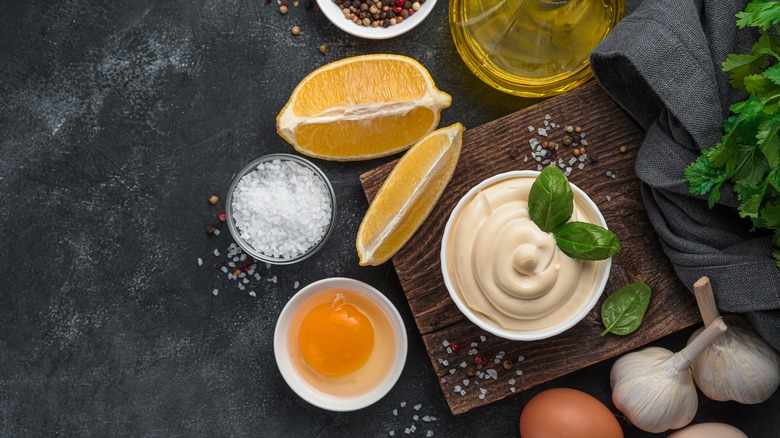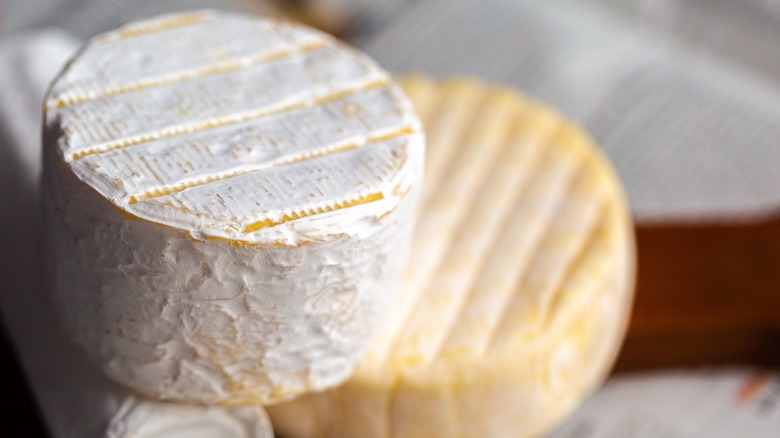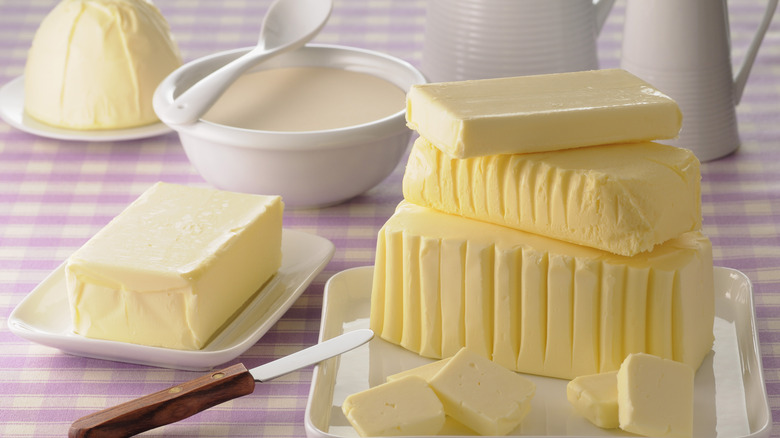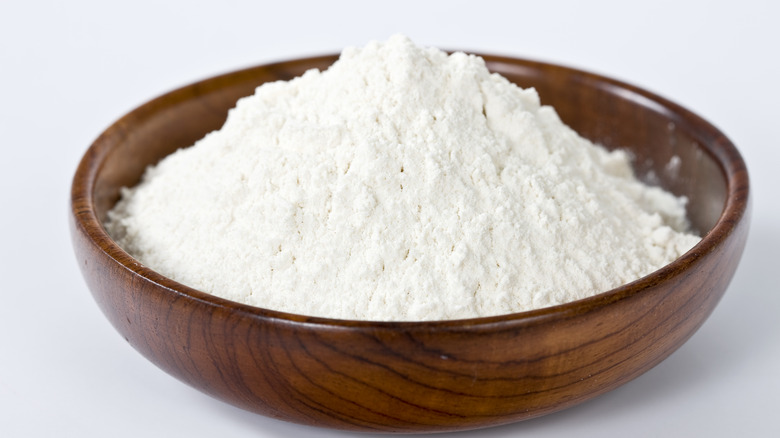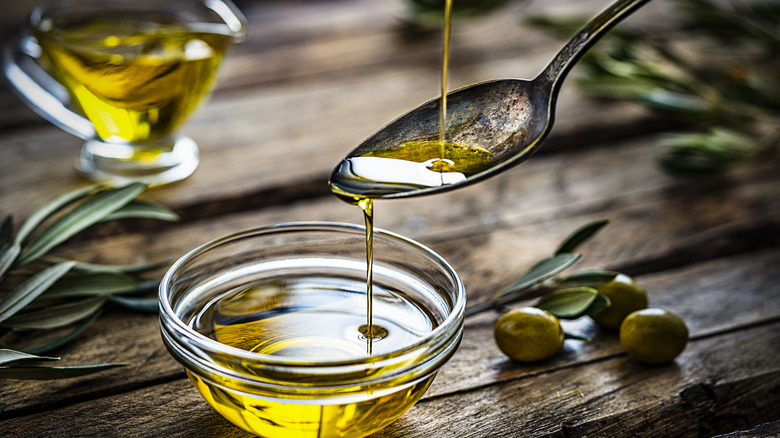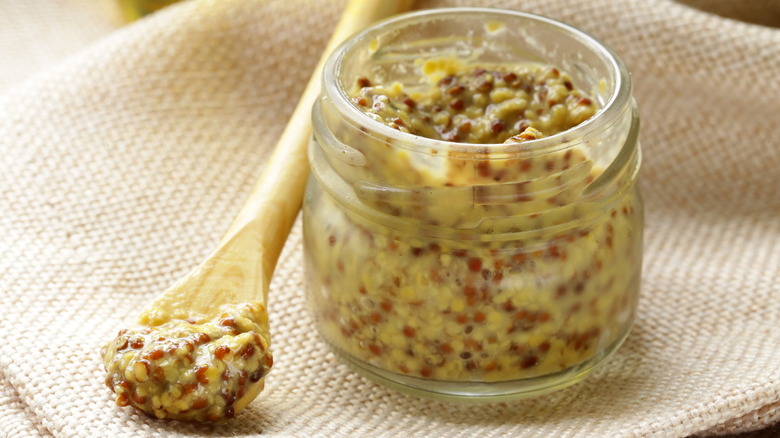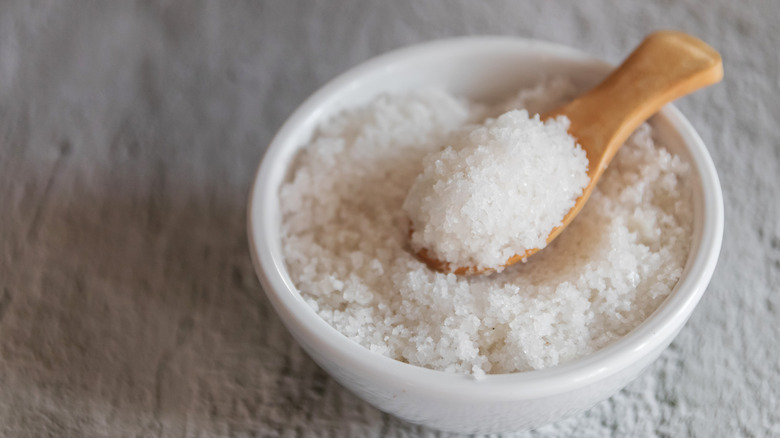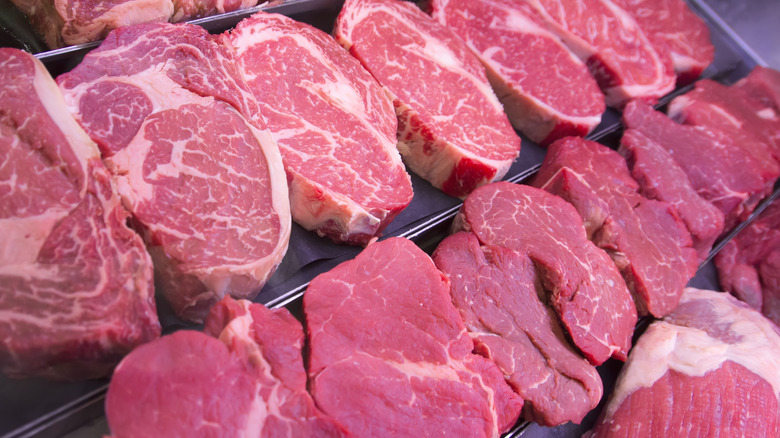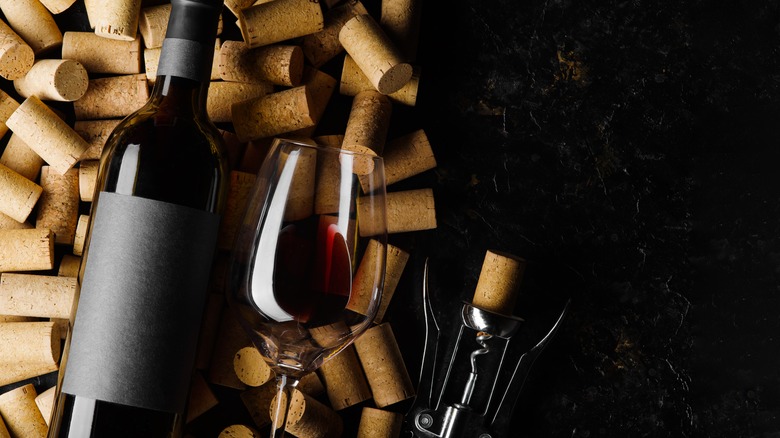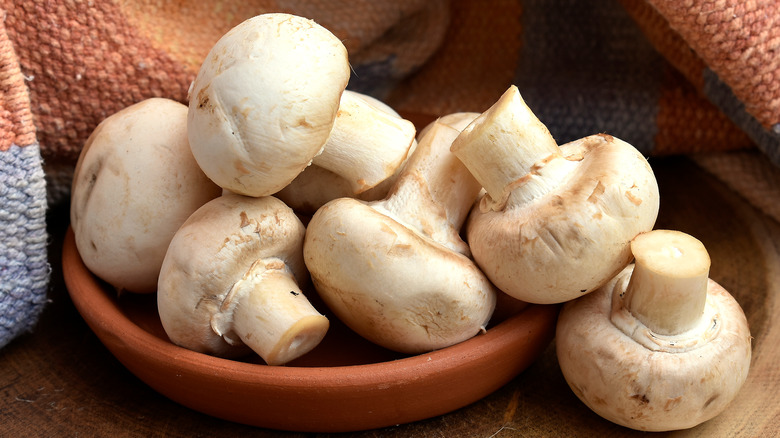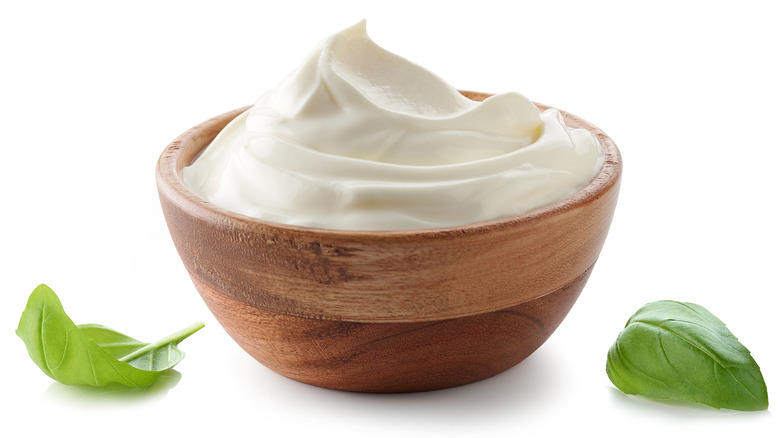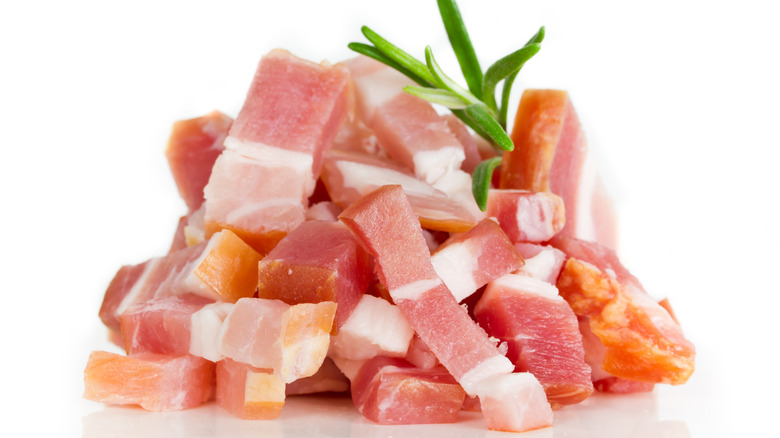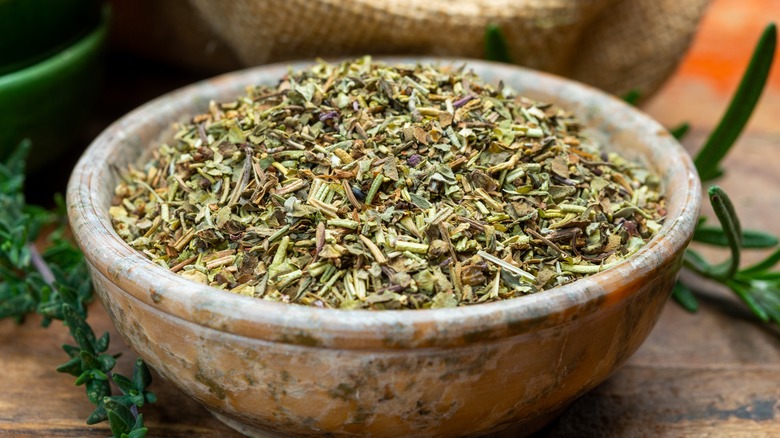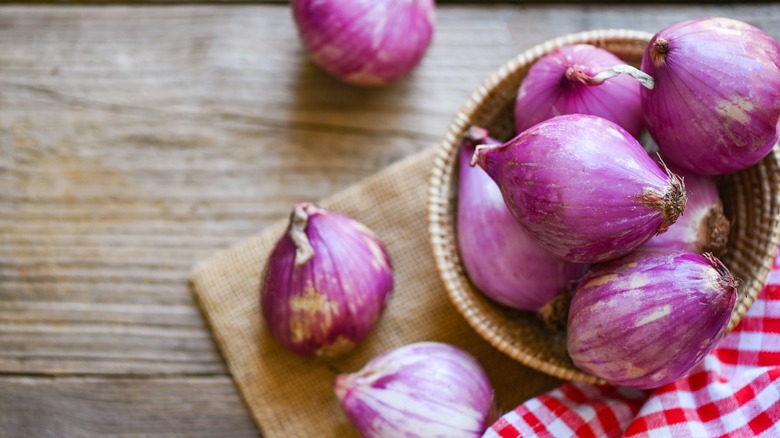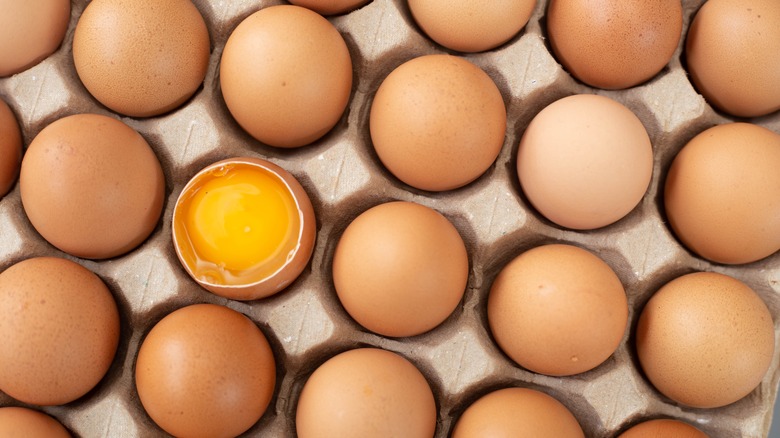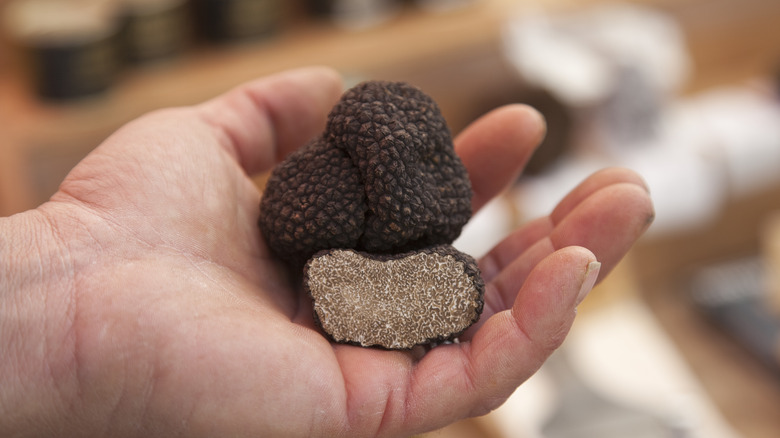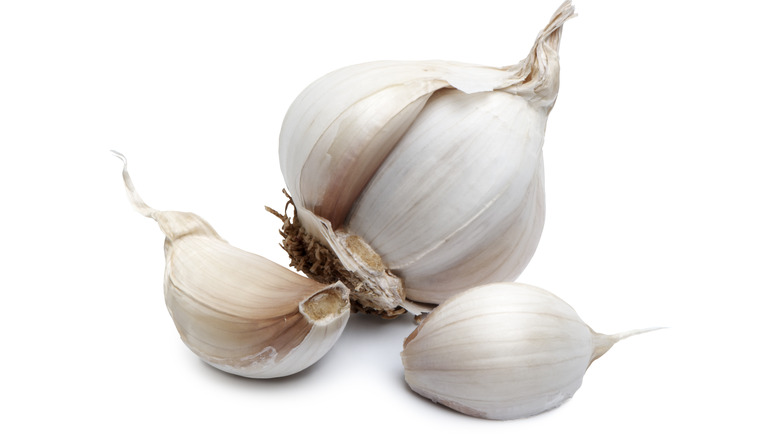16 Essential Ingredients For French Cooking
Let's start by stating the obvious — the French take their food seriously. Beyond mere sustenance, food in France is a reflection of the country's rich history and time-honored traditions. Don't believe us? Just look at France's recent UNESCO accolades. In 2010, the United Nations entity included the French gastronomic meal as an intangible piece of worldwide cultural heritage. And 12 years later, the same organization added the iconic French baguette to the list.
The attention is nice, but the French don't cook to impress to anyone. Rather, they cook to highlight the freshness of their local produce, demonstrate their mastery of complicated culinary techniques, and celebrate the unique flavors each region of the country brings to the table. In this article, we're shining a spotlight on 16 ingredients the French rely on when crafting their edible masterpieces. From specialty salt harvested near the craggy shores of Brittany to wine produced in the rolling vineyards of Bordeaux, you'll discover all of the necessary ingredients needed to emulate the flavors of this culinary juggernaut.
Cheese
Former French President Charles de Gaulle famously lamented about how difficult it is to govern a country with 246 types of cheese. That certainly sounds like quite the undertaking, but it's even more extreme when you consider that the true number of French cheeses is closer to 1,000. From the beloved planche mixte (a mixed cheese and charcuterie board) to the obligatory post-dinner cheese course, the French never miss an opportunity to indulge in the creamy stuff.
While the French are definitely partial to enjoying cheese on its own, they don't shy away from using it in their cooking. Consider Mornay, a cream sauce made by adding gruyère or parmesan to béchamel. Or what about chèvre chaud, a green salad made with warm goat cheese drizzled with honey? And let's not forget cheese-heavy winter dishes like fondue, raclette, and tartiflette. That might already sound like a lot of dishes, but these are just the tip of the cheese iceberg.
Butter
The French divide themselves in all kinds of ways. For instance, Paris Saint-Germain fans pit themselves against Olympique de Marseille supporters. In the summer, you'll find juilletistes (those who vacation in July) arguing with aoûtiens (those who vacation in August) about the best time to get away. As you might expect, these divisions also apply to food. While most of the country refers to chocolate croissants as pains au chocolat, those from the southwest call them chocolatines.
But nowhere are these culinary differences more visible than when comparing northern and southern styles of cooking. Southern cuisine is distinctly Mediterranean and olive oil-based, whereas northern cuisine relies heavily on butter. In fact, it's probably easier to name northern French dishes that don't contain butter than ones that do. Butter is a key ingredient in pastries, cakes, and baked goods. It's also essential for making sauces like beurre blanc (white butter), béchamel, and Béarnaise. What's more, it plays a leading role in simple sandwiches like jambon-beurre, a lunchtime staple made by slathering a baguette with salted butter and topping it with Jambon de Paris, a wet-cured cooked ham.
Flour
Flour is an important ingredient in many cuisines, but it's downright essential in French cooking. Think about it: baguettes, crêpes, croissants, and pastry dough would cease to exist without flour. So would espagnole, velouté, and béchamel (that's three out of the five French mother sauces if you're keeping track). Plenty more dishes rely on flour, but you get the point — French food without flour just doesn't work.
But using any old flour won't do when you're whipping up French delights. That's right, the French are sticklers even when it comes to flour. Delicate treats call for cake or pastry flour, while puff pastries and quiche crusts necessitate all-purpose flour. So far, so good, you might be saying. Not so fast. We haven't even begun to get into the complexities of French flour usage. Viennoiseries (aka croissants and brioches) call for either a 50-50 mixture of oatmeal flour and all-purpose flour or a 50-50 mixture of pastry flour and all-purpose flour. Confused yet? So are we. Better leave the baking to the experts and get back to doing what we do best — eating.
Olive oil
If you've been paying attention, then you know that dishes from southern France have a distinctly Mediterranean feel. That means these recipes contain all kinds of fresh vegetables, herbs, and seafood. They also rely heavily on olive oil, both as a standalone ingredient and as a base.
Take salade Niçoise as an example. Originating from Nice, this composed salad combines canned tuna, green beans, hard-boiled eggs, potatoes, onions, tomatoes, and olives. Olive oil is another essential ingredient, figuring prominently in the vinaigrette used to dress the salad (honorable mentions go out to red wine vinegar, Dijon mustard, and fresh herbs). Or how about ratatouille, a stewed vegetable dish made with zucchini, tomatoes, and eggplant? Olive oil is used to roast the garlic and cook the veggies to stewy perfection. Then there's bouillabaisse, a fish stew from Marseille. In this recipe, olive oil serves when making the fish broth, the rouille, and the bouillabaisse itself.
Dijon mustard
Sorry, no yellow mustard is allowed here. In French cooking, Dijon mustard is the star. Whether incorporated into a quiche Lorraine, mixed into a homemade vinaigrette, or slathered over chicken to make poulet à la moutarde, there's an infinite number of ways to add Dijon mustard to French dishes. Professional chefs and home cooks appreciate its tanginess, sharp flavor, and creaminess. It's also low in acid compared to other mustard varieties, a characteristic that allows the potent mustard seeds to take center stage.
As you might have guessed from the name, Dijon mustard comes from Dijon, a town in the Burgundy region of France. Dijon has long been known for mustard making, with the first batches arriving as early as the 1200s. Dijon mustard as we know it today arrived sometime in the mid-1800s when Jean Naigeon replaced vinegar with verjuice, a liquid made from unripe grapes. Grey Poupon, the world's most famous brand of Dijon mustard, arrived in 1866 when mustard maker Maurice Grey partnered with Auguste Poupon, a financial backer. Other popular Dijon mustard brands include Maille and Amora.
Fleur de sel
While it's far from being the most expensive salt in the world (that distinction belongs to Korean Amethyst Bamboo Salt), fleur de sel doesn't come cheap. At more than $30 per pound, this is a salt you'll want to use sparingly. Thankfully, its primary use is as a finishing salt for fish, steak, vegetables, and chocolate cookies. When sprinkled over finished dishes, fleur de sel (whose name translates to flower of salt) provides an eye-catching dose of richness and a satisfying crunch. The unique flavor comes from the high concentration of calcium and magnesium found in the salt.
There are two reasons why fleur de sel is so expensive. The first reason comes down to basic supply and demand. Plenty of chefs want it, but authentic fleur de sel comes from just a few places on earth, notably Guérande, a region in Brittany, and Camargue in Provence. Not only is the harvesting area limited, but each salt marsh produces just two pounds of salt per day. The second explanation for fleur de sel's high price tag has to do with the harvesting process. Fleur de sel is hand-harvested using a lousse a fleur, a special rake used to remove the top layer of salt from the surface of the water. You'll have to shell out to get your hands on some, but once you taste your dishes, you'll be glad you splurged.
Beef
The average French person eats nearly 85 kilograms of meat per year, with beef making up more than a quarter of that total. That amount seems impossibly high, but it's easier to understand when you consider all of the delectable beef dishes the French are known for. For starters, there's steak frites (steak and French fries), one of the most popular lunch dishes. Then there's steak tartare, a dish consisting of raw minced beef combined with onions, capers, and seasonings, then topped with a raw egg yolk.
You'll also find Hachis Parmentier, a minced beef and mashed potato casserole similar to shepherd's pie or cottage pie. But no French beef dish is more famous than boeuf bourguignon. Translated, the name means beef Burgundy, a nod to the dish's place of origin. The hearty stew is made by combining wine-braised beef and stock with bacon, bouquet garni, and vegetables such as carrots, pearl onions, garlic, and mushrooms.
Wine
Whether clinking glasses of champagne during an apéro hour, guzzling down a glass of rosé during the dog days of summer, or sipping on a perfectly-paired Bordeaux, there's no end to the wine-drinking occasions in France. In fact, the average French person consumes about 53 bottles of wine per year. While most of those bottles are for drinking, some are reserved for cooking.
Wine is a helpful addition to just about any recipe. However, some dishes, like coq au vin, rely on it. This dish, whose name means chicken in wine, is prepared by dousing chicken, bacon, and mushrooms in a red wine bath, then braising the ingredients for about an hour. Boeuf bourguignon is another French dish that relies on red wine braising to create its complex flavor profile. White wine also makes frequent appearances in French cooking. For instance, chicken chasseur (aka hunter's chicken) combines bone-in chicken with white wine, cognac, and mushrooms. But the ultimate flex is that the French manage to use champagne when cooking. Adding leftover champagne to seafood dishes provides tart, citrusy notes, along with some toastiness.
Champignons de Paris (button mushrooms)
Like a lot of French foods, champignons de Paris sound a lot fancier than they actually are. While their name means mushrooms of Paris, these edible fungi are nothing more than button mushrooms. Not to say there's anything wrong with that. In fact, humble button mushrooms are a staple of weeknight French home cooking. Not only are they healthy and easy to prepare, but they're also incredibly versatile. Without having to look too hard, you'll find them mixed into meat sauces, cooked alongside other vegetables, and stuffed with all manner of ingredients.
As a side dish, we love champignons de Paris à la crème (button mushrooms cooked in cream sauce) and fricassée de champignons de Paris (aka button mushrooms pan-fried with butter, garlic, parsley, fine herbs, salt, and pepper). They're equally delicious when added to quiche, omelets, risotto, and savory crêpes. When the colder months hit, they're an excellent addition to cheesy casseroles like tartiflette and gratin.
Crème fraîche
Your tongue may jumble trying to read the name of this French staple ingredient but fear not. Crème fraîche is essentially just cultured heavy cream. Like yogurt and sour cream, crème fraîche has a slightly tangy flavor profile thanks to the added bacteria cultures. In addition to its tanginess, crème fraîche features nutty notes, something that allows it to pair seamlessly with a wide variety of spices and other condiments.
Aside from its versatility, the French love this handy ingredient because of its high-fat content. Whereas sour cream contains between 18 and 20% fat, crème fraîche clocks in anywhere between 30 and 45% fat. The extra fattiness makes it an ideal addition to hot dishes. Not only does it thicken soups and cream sauces, but it does so without curdling. Besides stirring it into liquidy dishes, the French also use it to fluff up mashed potatoes and decorate desserts.
Lardons
You might think you're a fan of pork, but if you haven't tried lardons, you're missing out. They may not look like much, but these matchstick-cut pork slabs will put your bacon to shame, guaranteed. Not only are they crispier, fattier, and juicier than the sad strips you've been eating your whole life, but they're also infinitely easier to cook. Simply rip open the package, dump them into a pan, and cook until sizzling.
Thanks to their affordability, portability, and versatility, you're likely to find these convenient little morsels in pretty much every French person's kitchen. They're an essential ingredient in lighter dishes such as Lyonnaise salad, a classic bistro dish made by topping frisée with lardons and a poached egg. However, you're just as likely to see them in heavier meals like tartiflette and tarte flambée, a thin pizza-like dish from the Alsace region of France. That said, you don't have to be a French cooking expert to use lardons effectively. Mix them into pasta, throw a few into a quiche, or add some to lentils for a French take on the classic grain.
Herbes de Provence
French cuisine doesn't allow for a lot of shortcuts, but using herbes de Provence is one of the fastest ways to infuse your meat, vegetable, and egg dishes with flavors typical of the southeastern part of France. For many years, French home cooks and professional chefs used the term herbes de Provence pretty loosely. In other words, there wasn't a specific recipe for the herb blend. Rather, it was a general mixture of whatever summery herbs were available in the Provençal region of France. The modern recipe for the multipurpose herb blend appeared in the 1960s, when Julia Child featured Poulet Sauté aux Herbes de Provence in her iconic cooking manual, "Mastering the Art of French Cooking."
In the 1970s, French spice and herb brand Ducros became one of the first companies to produce the blend for international customers. Since then, Francophile chefs have been enjoying the savory blend of thyme, basil, rosemary, tarragon, savory, marjoram, oregano, and bay leaf. This mixture is incredibly versatile, providing woody and floral notes to dishes as diverse as soups, salads, and eggs.
Shallots
Pretty much every chef in the world keeps their pantry stocked with onions. But if you happen upon a French chef's storeroom, you're just as likely to see shallots inside. Smaller, sweeter, and less pungent than their white or yellow onion cousins, shallots are a staple of French cooking. France's love affair with these tiny alliums goes all the way back to the 11th century. At that time, the Greeks brought shallots from the Middle East to Europe. It wasn't long before the French started incorporating the bulbs into their recipes.
These days, you'll find shallots in a number of French sauces, including Béarnaise, Bercy, and Bourguignonne. They're also an essential part of shallot vinaigrette, a sauce served alongside oysters and shellfish. Outside of the sauce realm, you'll find candied shallots served with prime rib and roasted cod, raw shallots marinated with tomatoes in salad, and boiled shallots mixed into chutney. When fried, they're a satisfyingly crispy topping for meats and casserole dishes.
Eggs
Relying on eggs isn't exactly limited to the French. After all, Israelis have shakshuka, Italians have frittata, and the Japanese have tamagoyaki. But as with many food-related things, the French have taken this simple ingredient and transformed it into masterpiece after masterpiece.
On the simple end of the spectrum, you'll find quiche, oeufs brouillés (aka loosely scrambled eggs), and oeufs cocotte (aka baked eggs). Moving into more complicated territory, a single fried egg turns a croque monsieur sandwich into a croque madame. Come dinner time, you might be tempted to whip up oeufs en meurette, a refined dish made by poaching eggs in Burgundy pinot noir, but this deceptively simple dish isn't for the faint of heart. That said, the most complicated French egg dishes are those that look the simplest. We're talking about fluffy cheese soufflés and omelets. When they're not the star of the recipe, eggs play a supporting role in pastries, crêpes, and chocolate mousse.
Truffles
Known as the fruit of fungi, truffles attach themselves to tree roots and engage in a symbiotic relationship with the host. The truffles find water and minerals in the soil, then pass these vital products to the tree. In exchange, they receive sugars from the tree, something that contributes to their unmistakable aroma and flavor. Unfortunately, they're rare, tricky to harvest, and have a shelf life of just a week or two. Together, these factors contribute to their high price tags. In fact, some truffle varieties go for as much as $300 per ounce.
Still, there are less expensive varieties to explore, and the French definitely aren't shy about shaving truffles over pasta, pizza, or risotto dishes. Indeed, these umami-rich fungi pair well with just about anything you can think of. Truffle butter, truffle cream, and even truffle ice cream are just a few of the ways to incorporate these tasty treats into your cooking.
Garlic
Saying that the French love their garlic would be an understatement. Rather, it's more accurate to describe these humble bulbs as the heart and soul of French cooking. You'll find garlic in all of the typical places — in pasta, alongside chicken, and mixed into sauces — but that's just the beginning. Indeed, the French have elevated the use of garlic into an art form.
Take aïgo bouido as an example. This Provençal soup masterfully blends roasted garlic, herbs, and olive oil to create a comforting broth that pairs beautifully with a sprinkling of gruyère. Then there's aioli, a cold, creamy condiment made by combining finely chopped garlic with olive oil, egg yolks, and fresh lemon juice. Some people may call it garlic mayonnaise, but they're wrong. This heavenly sauce goes way beyond mayonnaise's limitations, serving as the perfect complement to fish, seafood, and a number of vegetables. You can even mash it into potatoes, spread it on a sandwich, or drizzle some over a grain bowl. Really, the uses for aioli are endless.
